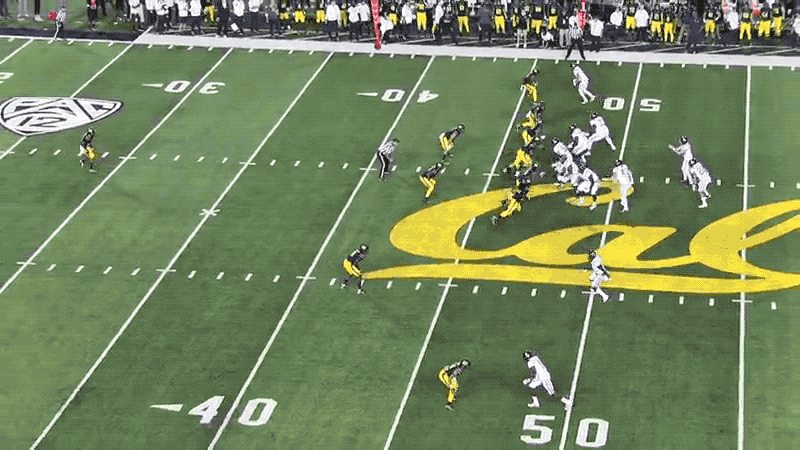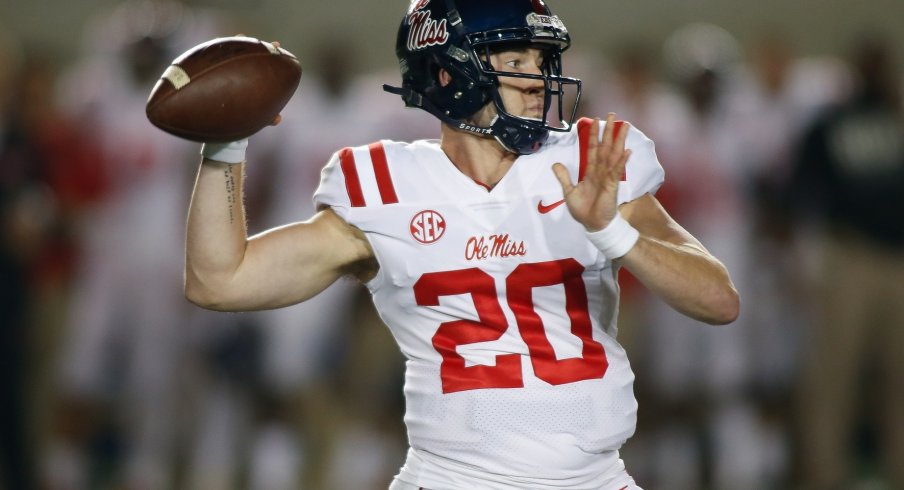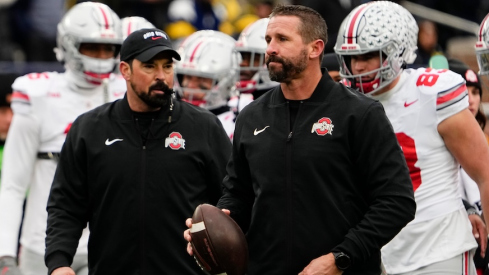Despite the battle between Dwayne Haskins and Joe Burrow for Ohio State's starting job this Spring, the quarterback situation in Ann Arbor seemed to draw more national attention thanks to the presence of Shea Patterson.
Patterson, of course, was once the top recruit at the position in the class of 2016, signing with Hugh Freeze and Ole Miss after capping his prep career at the prestigious I.M.G. Academy in Florida. Though only 6'1" and a shade under 200 lbs with good athleticism as a high school senior, he was listed as a "pro-style" QB thanks to his outstanding arm strength.
Now, after two seasons in Oxford, Patterson was granted immediate eligibility to play for the Wolverines after the Rebels were hit with a bowl ban and scholarship reductions stemming from numerous recruiting violations under Freeze's watch. Understandably, this news has been more than welcome to fans of the maize and blue, who've felt that despite Jim Harbaugh's reputation for developing the position, his team's lack of talent at quarterback has been what's kept the program from regaining their rightful spot atop the college football world.
For readers of Eleven Warriors, this whole charade has probably seemed like background noise, given the focus on Haskins and Burrow here over the past few months. However, now that both teams have found their expected leaders under center come the fall, it's time to examine what, exactly, this incoming transfer means for the Buckeyes' biggest rivals.
This is not meant to scare Ohio State fans nor to undercut the hopes of the Michigan supporters in our lives. Rather, this is a simple collection of observations based on what Patterson showed in seven games before suffering a season-ending leg injury last season.
The first thing anyone notices when watching Patterson's film is not just that he has the arm talent to push the ball downfield, but that he can do so with accuracy. Here, he recognizes that the defense is in man-coverage with one deep safety in the middle of the field, and drops in a beautifully thrown ball that not only hits the receiver in stride but is down the sideline and away from that lurking safety.

Michigan has long been able to find statuesque quarterbacks capable of throwing the deep ball, but rarely have they ever had someone under center capable of this as well:
With that combination of arm, vision, and athleticism it's understandable why the locals in Ann Arbor were so excited for his arrival. However, it should be noted that Patterson will be learning his fourth offense in as many years, and Harbaugh's pro-style system is the clear outlier of the group.
Like most high schools in this era, I.M.G. featured a shotgun-spread that was similar to the one Freeze and coordinator Matt Luke introduced to Patterson upon his arrival at Ole Miss in the fall of 2016. The duo had long been considered at the cutting edge of spread offenses, pioneering uptempo, RPO-heavy game-plans long before Chris Collinsworth tried to describe them during the Super Bowl.
But once Luke took over following Freeze's dismissal last fall, he handed the reigns over to yet another progressive thinker, Phil Longo. The former Sam Houston State offensive coordinator made a name for himself by pioneering what has been called the 'Power Air Raid,' combining the basic passing philosophies of Mike Leach with a ground game similar to that of Urban Meyer, all while going uptempo and often running 90 plays or more during a game.
Though he's quick to mention the influence of Leach and Kliff Kingsbury, the product Longo puts out on the field looks far more like the Baylor offenses seen under Art Briles, stretching defenders from sideline-to-sideline and throwing vertically. With the defense so spread out, any coverage essentially becomes man-to-man as there is rarely a second defender nearby, leaving the players on an island against Longo's well-coached receivers.
As a result, Patterson was given clear responsibilities to identify to matchup he wanted and wait for the receiver to gain separation from his opponent. Sometimes that meant leading him inside on a slant route...
...while at other times, that meant throwing a comeback against soft coverage, timing up his throw across the field with the break of the receiver and hitting him right in the numbers.

As Longo told Bruce Feldman in the fall of 2016,
"We don’t even call them reads,” Longo said. A QB “reading” to see a linebacker’s hips or shoulders or his movement in regards to a nearby wideout and slot receiver usually dictates the quarterback assessing—and projecting—what will be the most difficult situation and throwing the opposite. “We don’t do that. I think that adds another step. It’s about trusting our receivers to attack the space and get in the right place."
“We ask our receivers to run their route based on how the defenders in their area of the field are reacting. For instance, a Hook route’s going to look different vs. Cover 3 than it would vs. Cover 4 or vs. Cover 6.”
This focus on allowing the quarterback and receiver to play instinctively resulted in a passing game that essentially revolved around one-on-one matchups, an approach that largely favored the Rebels thanks to their big and talented receiving crew. It's no wonder, then, how Patterson was able to rack up 928 yards with nine passing touchdowns during the first two contests of 2017 against outmatched South Alabama and Tennessee-Martin squads.
Once the Rebels began taking on their in-conference SEC rivals, the tune changed a bit, as the young receivers had trouble winning those same one-on-battles against the talented secondaries of Alabama, LSU, Auburn, and even Vanderbilt. To account for this upgrade in ability, Longo began relying heavily on screens and RPOs, giving Patterson quick reads that got the ball into the hands of the playmakers around him quickly.
Here we see Longo package a simple inside zone run to the boundary with a slant from the slot receiver, asking Patterson to quickly read the movements of the SAM linebacker.
Similarly, against LSU's talented defense, Longo combined a counter-trey run that pulled the backside guard and the tight end across the formation, bringing the outside linebacker with them and opening up a throwing lane for another slant to the slot.

But as shown by the receiver dropping what should have been a completion above, Patterson's teammates deserve plenty of blame for the offense's poor showings against Alabama and LSU. Often, Patterson was running for his life against those talented defenses, thanks to the turnstile blocking techniques of his protectors.

Defenses often sent extra pressure toward Patterson, as the quarterback showed to be very uncomfortable against an incoming pass rush. Instead of waiting for his receivers to break open on those long-developing vertical routes, Patterson would simply get rid of the ball as soon as possible to avoid getting hit.
Even when the rush wasn't in his face, Patterson seemed to lose all faith in his fundamentals against these talented fronts, as he showed below by doing just the opposite of the first example shown above. With the defense in Cover-1 once again and the free safety patrolling the middle of the field, Patterson is so anxious to get rid of the ball that he fails to lead the receiver toward the sideline and instead throws directly toward where the safety is waiting.
But this lack of basic fundamental discipline in Patterson's footwork didn't only show up against the good teams. Here, against the vaunted Cal Bears and their defense that would finish 113th nationally against the pass, Patterson flees the pocket despite the tackle maintaining good position in his vertical pass set. Instead of simply stepping up in the pocket to find the releasing back for an easy gain, Patterson ran 30 yards and threw across his body for an incompletion.

Similarly, since he wasn't coached in the traditional sense of timing his drops with the routes he's reading, his upper and lower body were often out of sync on check-downs, resulting in inaccurate throws. Watch below as his feet are pointed forward while he tries to sling it toward the sideline.

Add that to the fact that his release is already a bit funky, with a low release point and an incredibly wide stance to create power from his back leg, and it's clear that Harbaugh and quarterbacks coach Pep Hamilton have their work cut out for them. While learning a new system may not be unfamiliar to Patterson, the demands placed upon the signal-caller in Harbaugh's offense likely will be.
Instead of relying on their physical gifts and simplifying the process as much as possible for the players in the system, as Longo tried to do, the Wolverine offense is built on precision. While he's certainly capable athletically of taking five and seven-step drops from under center, Patterson will have to tie those drops to the location of his receivers. He'll have to find his first read at the top of his drop, then take a hitch step and find number two, then repeat down the line, all of which can't be done properly until he's first identified the coverage, of course.
Additionally, his relative carelessness with the football won't be tolerated, as nine interceptions in seven games isn't a sustainable rate in the Wolverines' ball-control offense. Given this focus on maintaining possession, however, Patterson opens up new avenues for a stagnant Wolverine running game that finished 61st in yards-per-attempt last season and was especially poor in the red zone, where they averaged only 2.88 yards-per-carry. Patterson's ability to operate in the option game opens up new territory for a staff that has lacked the personnel to recreate the quarterback running game that was so successful in their time with the 49ers.
But both Patterson and the staff will need more than a few weeks in April and August to get comfortable. Expecting him to have mastered his new assignment by the time they travel to the South Bend for the season opener would be audacious, but the real test will come for the Wolverines when they face a rough three-game stretch against Wisconsin, Michigan State, and Penn State beginning in mid-October.
Just as Iowa transfer Jake Rudock started slowly before finishing strong in 2015, his lone season with the Wolverines, Patterson's trajectory will likely continue to rise as the season goes on. Given his natural abilities, however, where he lies on that path come late November is something Ohio State fans will want to keep a close eye on.



